Blue Ocean Strategy: 7 Steps to Ignite Business Transformation
“Blue Ocean Strategy,” by W. Chan Kim and Renée Mauborgne, is a pioneering blue ocean…
Insight Team
January 1, 2025
The last chapter explored the customer development process, a framework mentioned in “The Startup Owner’s Manual” by Steve Blank and Bob Dorf. This method is all about understanding what customers want and need.
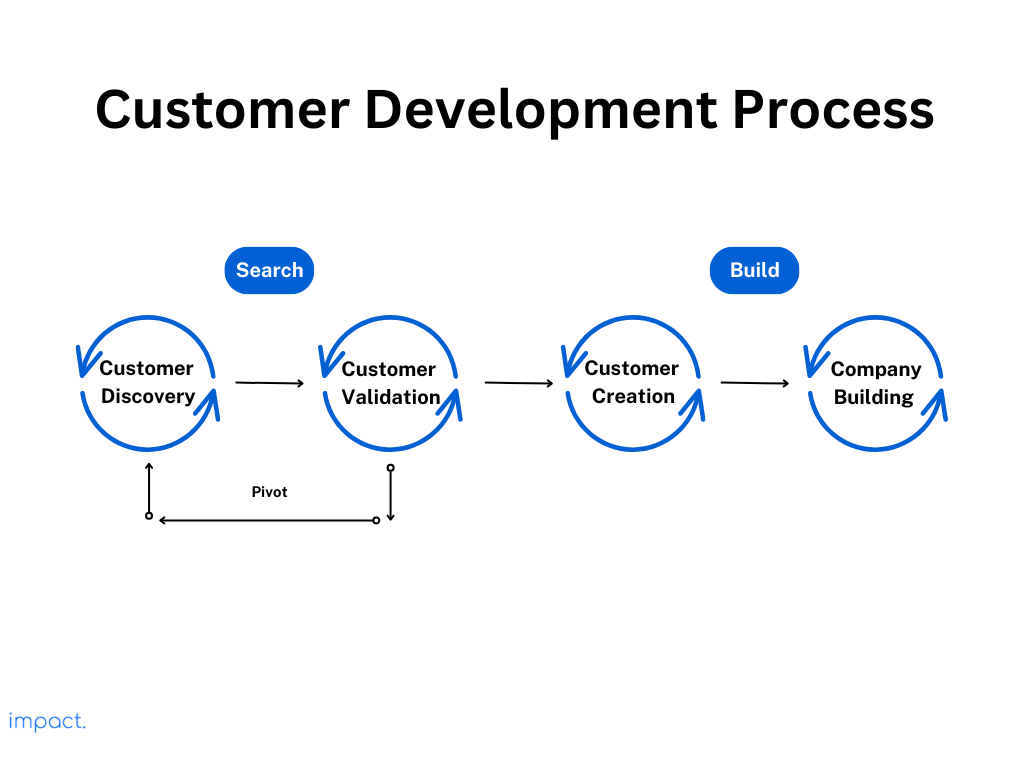
The model follows four steps:
In this chapter, we’ll get down to business and see how to apply this idea to building a company. We’ll look at the practical steps to make your startup connect with your customers better.
We’ll also dive into the Customer Development Manifesto, which has 14 principles to guide startups like yours. These principles will help you stay focused on your customers and set you up for success.
Read more: Startup Essentials: Key Definition and 9 Mistakes to Avoid
The customer development process allows entrepreneurs to test their ideas before going all-in when building a company. It helps them determine if their products solve a problem for their potential customers.
Instead of mindlessly investing time and money, entrepreneurs follow a systematic four-step approach to validate their ideas. Here’s a simple step-by-step guide to implementing the customer development process:
Starting a startup begins with your idea for a new product or service that meets your customer’s needs and how you plan to reach many customers. Customer discovery helps you avoid wasting money and getting nothing in return. Your primary objective is to turn your initial ideas about the market and customers into solid facts.
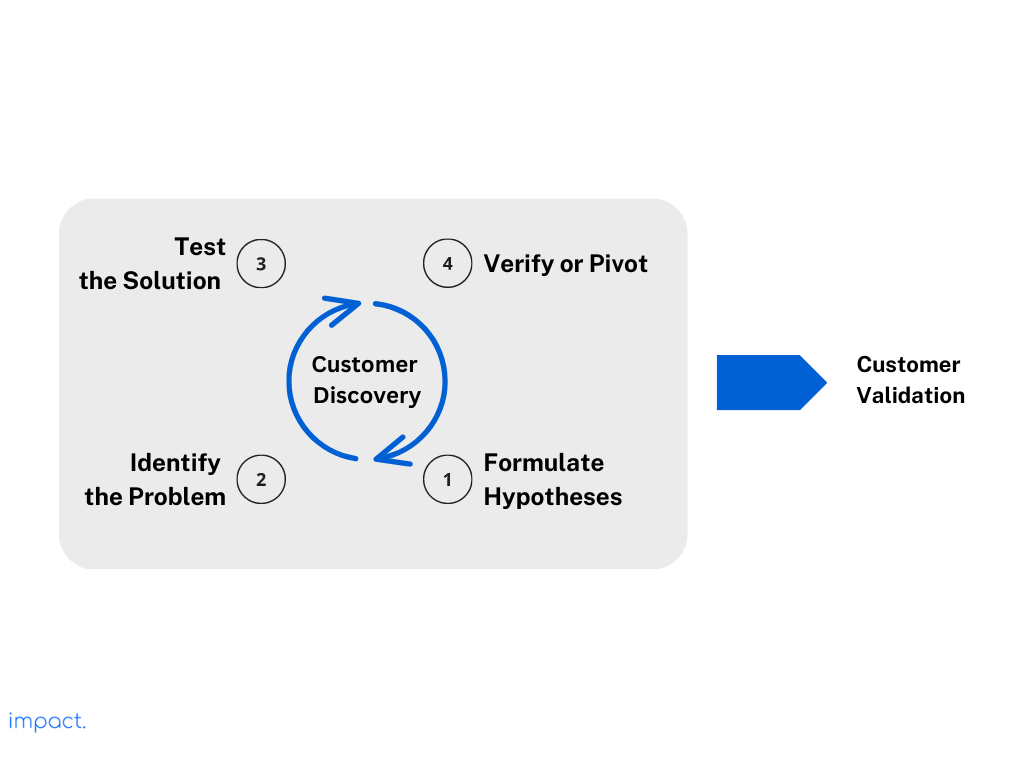
To get started, have a clear vision and assumptions in mind. Understand the problem thoroughly before finding a solution. Identify the target audience you want to help and develop different potential solutions. Use your research and market knowledge to create these hypotheses.
To start a successful startup, first, find a big problem or something people need but don’t have yet. This problem should be substantial enough that people want a solution for it.
Don’t just sit inside and guess what customers want. Go out and talk to them about where they live. Spending ample time with your customers is crucial for profoundly understanding their needs. These are some actions that you can take at this stage:
This process requires extended engagement, possibly lasting months. Remember, your product should be designed for a specific group of people, not for everyone. And don’t wait until you have customers to start building your product. Start building it early, even if you’re unsure if anyone will buy it yet.
To test your solution for the identified problem, you’ll need to develop a Minimum Viable Product (MVP) or a basic version of your solution that addresses the issue. The MVP should include your product, pricing, features, and other business model components.
Next, offer the MVP to a small group of early adopters. Early adopters are enthusiastic individuals who have a problem or need and understand they have one. They actively search for a solution and have a timetable for finding it. These early adopters might already have a temporary solution because the problem is bothering them significantly.
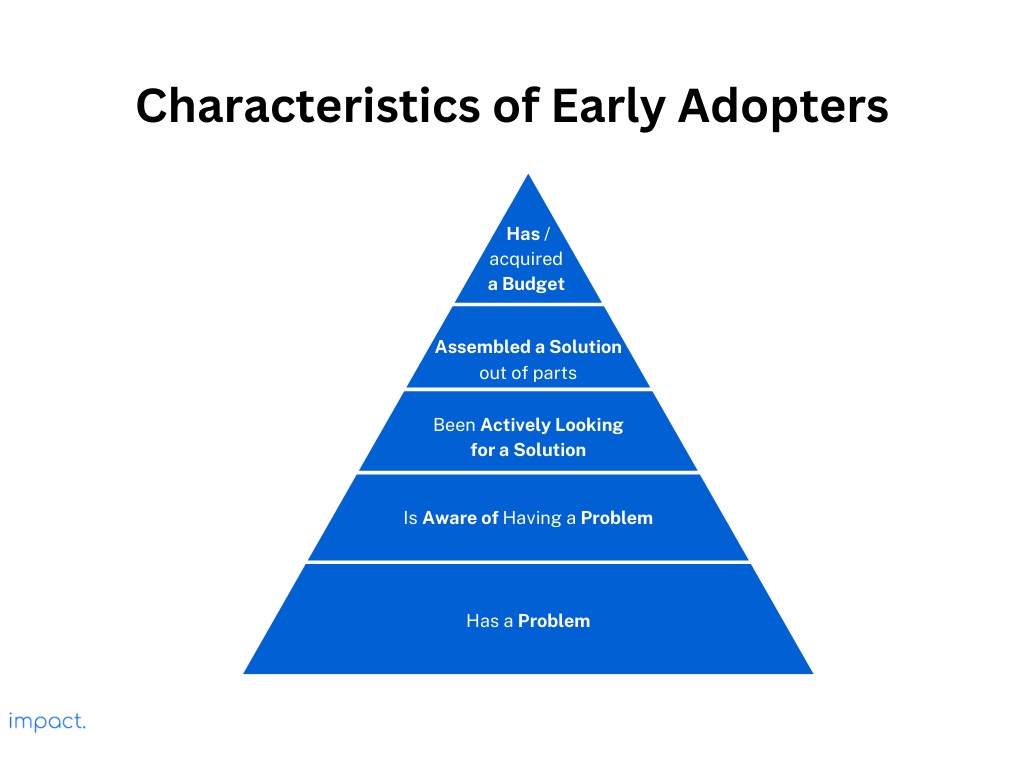
Observe how potential customers use your MVP and collect feedback. Early adopters can help promote your product through word-of-mouth. Compare their responses to determine success or areas for improvement.
In the final phase of customer discovery, you must verify and pivot as necessary. Look closely at the feedback you received from potential customers in both problem and solution testing stages. This feedback should have given you a good understanding of their needs, how much they’re willing to pay, and the potential customer base.
The key questions are whether there is enough demand for your product and whether your solution effectively addresses the problem. If the feedback is positive and supports your initial assumptions, you can move on to the customer validation phase.
However, if the feedback indicates significant changes are needed, be open to pivoting your product strategy to better align with customer needs. Remember, adapting and refining your approach based on what you learn from potential customers is essential.
In customer validation, the goal is constantly testing the product’s potential. This phase involves a series of pass/fail tests to assess whether a match between the product and the market is strong enough. It is a crucial step to know if your business can scale. Like the customer discovery phase, customer validation also follows four essential steps.
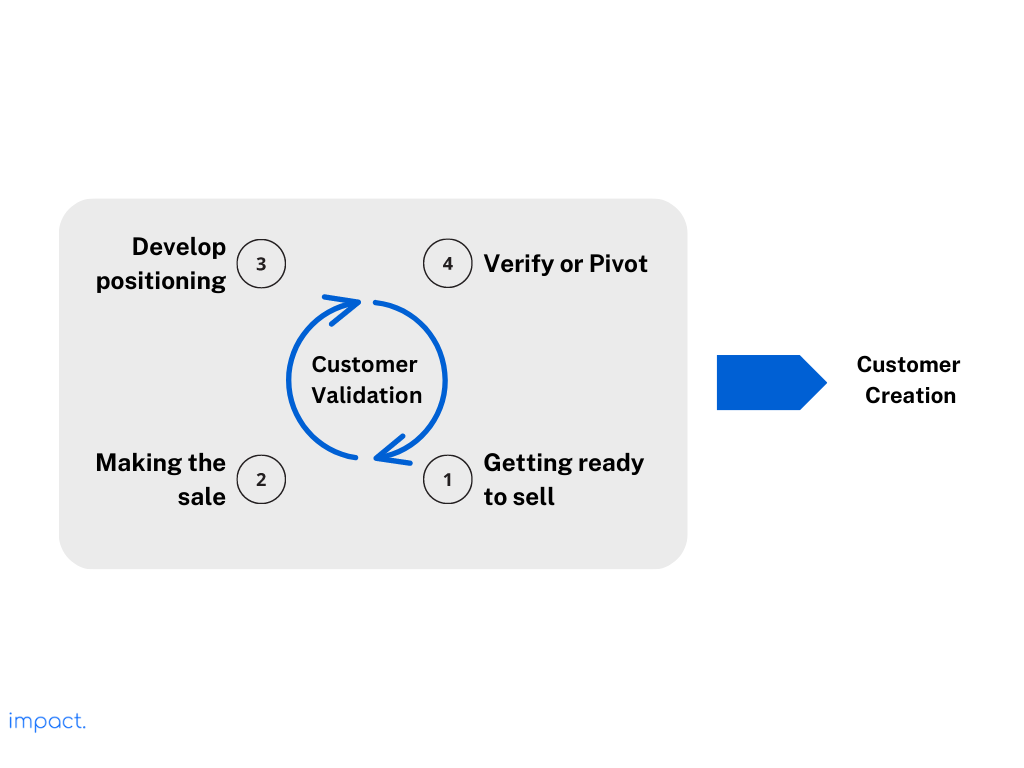
Prepare your product or service for the market using the insights from the Customer Discovery Phase. As you gear up to make sales, focus on these six critical activities as you move forward:
By completing these activities, your team will be well-prepared to enter the market and effectively engage with potential customers, making your early-stage venture a strong contender in the industry.
This step determines if your business model can work well in the real world. Startups use materials like brochures, PowerPoints, product demos, or mockups to gather valuable insights during meetings with potential customers.
Founders need to actively participate in selling to test their business model. The main objective is to determine if customers are interested in buying their product and if the value proposition is valid.
To do this, reach out to potential customers with your Minimal Viable Product (MVP). The feedback you receive from these interactions is essential for refining your product presentation, sales roadmap, and channel plans. This process helps you understand if your business can repeat, scale, and become profitable.
In this step, you already have some orders and enough customer information to work with. It’s time to develop and refine your product and company positioning.
Test this positioning with industry experts, analysts, and a broader customer audience. Make sure to communicate the unique value of your product or service to potential customers. Highlight how your offering solves their specific problems and stands out from competitors.
Customer validation is confirmed when you see actual orders, users, or clicks—not just survey responses or casual chats. It shows that customers accept your minimum viable product and that there is a real market. You also figure out how to consistently reach these customers and create a scalable plan to sell your product to many more of them.
You can start enjoying the benefits once you’ve confirmed that customers like your idea. But before that, there are some challenges and work to ensure everything is verified and ready to move on to the Customer Creation phase.
If things don’t go as expected, like in the Customer Discovery phase, you may need to make changes (pivot). It could mean adjusting the design, changing the messaging, or switching to an entirely new product.
Once you have confirmed that customers are interested in your idea, you move on to this step to implement your business plan. During the Customer Creation Phase, your main goal is scaling your startup. Here are the steps involved in this phase:
During this step, your main goal is to create a well-planned strategy to reach more people and get potential customers interested in your product or service.
Identify the most effective channels to communicate why your product is unique and worth trying. These channels could include social media, online ads, content marketing, emails, or traditional methods like print ads or billboards.
Make sure your marketing messages connect with your target audience. Show them how your product can solve their problems and benefit them.
Now that you have a marketing and sales plan, it’s time to implement it and reach a larger group of customers. Your goal is to attract more customers and grow your user base.
To attract more customers and grow your business, focus on these steps:
As you implement your marketing and sales plans, consider essential metrics (KPIs) to see how well you’re doing. Monitor metrics like customer acquisition cost, which tells you how much money you spend to get each new customer.
By determining the effectiveness of your marketing and sales efforts, you can ensure the success of your business. With careful strategy implementation, you can expand your customer base and increase your chances of achieving growth.
Read more: Unlocking Growth: 19 Traction Channels for Business Success
Once your company successfully scales, you enter the Company Building phase. Here, your business transitions from a startup to a mature company. Some steps involved in this phase are as follows:
As your business grows, build a team that works well with your abilities and shares your company’s vision. Look for people who are enthusiastic about the product and dedicated to making it successful. Surround yourself with like-minded individuals to support and drive the company forward. A passionate and committed team will enhance your chances of achieving your goals and vision for the business.
To handle more customers effectively, improve your internal processes. Streamline your operations, manage resources efficiently, and provide excellent customer support. These changes will help you accommodate the growing customer base and deliver better service. By optimizing your internal processes, you can enhance your overall business performance and ensure customer satisfaction.
Create a culture where continuous improvement and innovation are valued. Encourage employees to try new things and learn from mistakes. This way, you can drive the growth and progress of your product and company.
By embracing a culture of learning and adaptability, your team can stay ahead in the market and find better ways to serve customers. Don’t be afraid to take risks and embrace change as opportunities for improvement. It will lead to better products, happier customers, and a more substantial business overall.
Building a company using the Customer Development Model is not an easy task. It requires real effort, and you can’t pretend to do it. Changing the way to build a startup requires a serious commitment.
Steve Blank has 14 critical principles for startups using the Customer Development process. Think of these principles as rules that both small and big companies should follow when they embrace this approach. Remember these principles from the beginning and review them regularly as you build your business.
Step outside your office to interact with potential customers directly. Avoid relying solely on internal assumptions; instead, validate your ideas and hypotheses by engaging with real customers in the field.
Combining customer development with agile development is a powerful way for startups to create products that customers love. Agile development involves building products in small, functional steps and making quick adjustments based on feedback.
This integration means startups get valuable insights from real customers throughout product development. The startup ensures the product meets their needs and preferences by involving potential customers.
With customer development and agile working together, startups can be more responsive and adaptive to customers’ wants. This customer-centric approach leads to better products and happier customers in the end.
There’s an essential difference between existing companies in startups: startups often experience failures. But don’t worry; failures are learning opportunities. Not all initial assumptions will be correct, and that’s okay. Use failures to improve and find what works best.
Failures are a natural part of the startup learning process. You’ll run many tests; some will succeed, while others won’t. When things don’t work out, successful founders adapt to the new information, figure out what needs fixing, and take action decisively. So, embrace failure, learn from it, and keep moving forward.
Pivoting is a crucial part of the customer development process. It means making significant changes to your business model based on customer feedback. You continuously improve your product and strategies by listening to customers. You should be open to pivoting to meet customer needs, and market demands better if needed.
A pivot doesn’t always mean completely changing your entire company. Sometimes, it’s just about addressing one significant problem or changing a specific area. When to pivot depends on your startup’s situation. After reviewing your company’s current status and prospects, it should be a carefully considered decision, not a quick reaction.
While some startups have experienced great success after pivoting, it’s not a magical solution for all problems. It is advisable only to pivot when necessary and after exhausting all other alternatives. It’s a thoughtful and strategic decision to ensure your startup’s growth and success.
The primary purpose of a business plan is often to appease investors who may request one. However, once you secure financing, the business plan loses its significance. Many entrepreneurs mistakenly treat the business plan as a rigid execution manual, failing to grasp that it primarily consists of unproven assumptions.
As you interact with customers and gain real-world experience, you will realize that your business plan needs to evolve. Startups should abandon the traditional business plan and embrace a more adaptable and flexible business model. Be prepared to make adjustments based on customer feedback and insights. Stay open to change and be willing to adapt your approach according to what you learn from your customers.
A hypothesis is like a fancy word for a “guess.” To turn beliefs into facts, founders need to test them. Think of your business hypotheses as experiments that need validation.
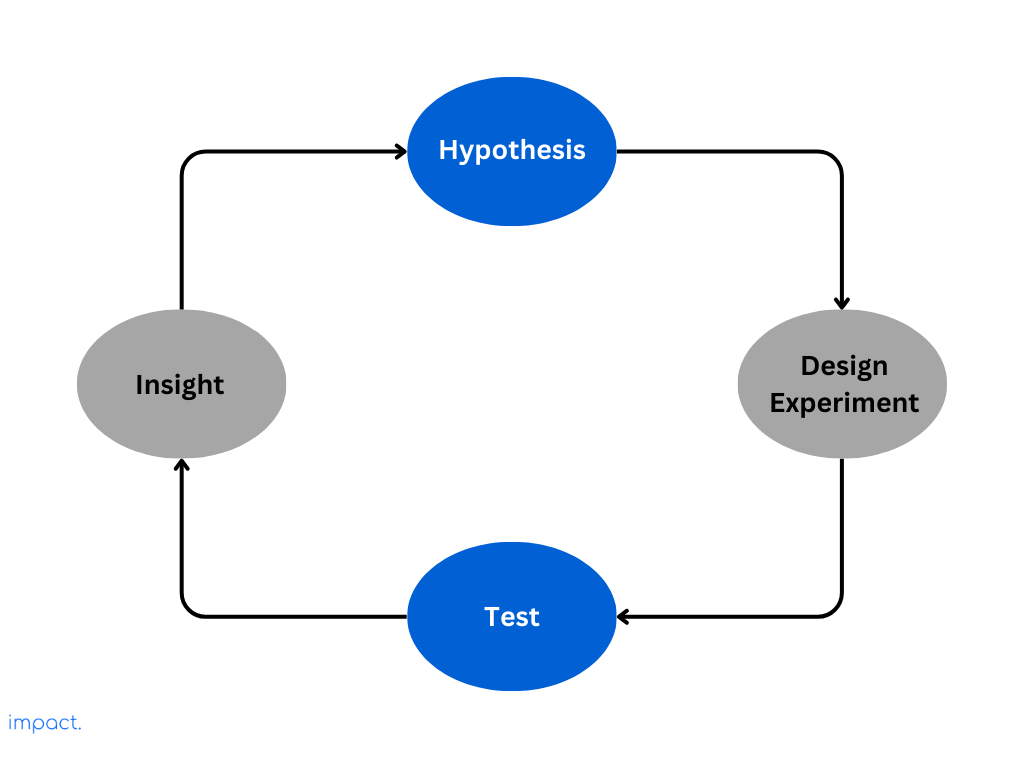
Design these experiments to confirm or challenge your assumptions. Use data-driven insights from the experiments to make informed decisions for your business. Using this approach, you can make informed decisions backed by evidence, thereby improving your chances of success.
Startups are not all the same. One significant difference is how a startup’s new product relates to the market. You must identify the type of market you are entering – it could be an existing market, a resegmented market, a new market, or a copy of a successful business.
Understanding the market type will influence your strategies. Most startups fall into one of these four market types and must choose one to commit to. Making the wrong choice can have severe consequences during the customer creation stage.
Startups need to identify and track metrics that are relevant to their growth. In the past, startups used traditional financial tools like P&Ls, balance sheets, cash-flow forecasts, and other analyses because they didn’t know what else to measure.
However, metrics for startups should focus on tracking their progress in turning their assumptions and guesses into solid facts rather than just measuring the execution of a fixed plan. It’s crucial for both the board and management to continuously test and measure each assumption until the entire business model is ready to scale into a full-fledged company.
A startup board should also track a few critical financial metrics. These include the cash-burn rate (how quickly the startup spends cash), cash runway, short-term hiring plans, and break-even point timeline.
By tracking these metrics, startups can make informed decisions, stay financially healthy, and increase their chances of success.
In startups, quick decision-making and action are crucial. Startups must respond swiftly to market feedback and seize opportunities. Speed is essential because startups face constant financial challenges, and time is of the essence.
Rule No. 4 talks about iterations and pivots but doesn’t specify how long they should take. The faster these learning, building, and pivoting cycles happen, the better the chance of finding a successful business model with available funds.
Speed is essential inside the company too. Making decisions for startups can be difficult due to uncertainty, and there may not always be a perfect solution. It’s important not to waste too much time trying to find the ideal answer and instead focus on making the best decision possible with the information available.
For a startup to succeed, it needs passionate individuals who embrace uncertainty and change. Founders and teams must be dedicated to their vision and ready to face challenges.
These people prioritize customer needs and work hard to deliver excellent products. They commit to the vision around the clock, not just during regular working hours. These passionate individuals are the driving force behind the startup’s high growth.
In startups, roles are flexible, and employees often have multiple responsibilities. Job titles are not rigid; everyone must contribute to the company’s success.
Startups need a different kind of leadership compared to big companies. They require leaders who are:
Moreover, teams in startups must be able to:
Managing your cash wisely and spending when needed is crucial in Customer Development. The main aim is not to avoid spending money altogether but to be careful with expenses while searching for a business model that can be repeated and scaled. Once you find that successful model, you can spend more confidently growing your business. It’s all about being smart with your resources until you find the right path to success.
Sharing everything learned outside the building with employees, co-founders, and investors is crucial to building a startup. It’s essential to emphasize learning from both successes and failures. Thanks to technology in the 21st century, we now have tools that make communication easier. We can share what we are learning in almost real-time with everyone who needs to know. This open and continuous communication helps the team stay informed and make better decisions to drive the startup’s success.
Customer Development’s approach to learning and discovery can be quite different from what many people in the business world are used to. If you’ve spent your career following a set plan, it can be disorienting. That’s why it’s crucial to have everyone involved in the project, from the top to the bottom, fully onboard and understanding that this process is fundamentally different.
This approach changes everything: how we behave, how we measure success, and how we perform. It’s not a linear process; it’s more like an ongoing search for a business model, sometimes taking years. So, everyone on the team must embrace and accept this unique way of working to ensure it succeeds.
The Customer Development Model is a powerful tool for entrepreneurs seeking to turn their ideas into successful businesses. It’s a systematic approach that allows you to test your concepts, ensuring that your product addresses a genuine need in the market before diving headfirst into the business world. Building a company with this model requires dedication and wholehearted commitment.
Steve Blank’s “The Customer Development Manifesto” offers 14 critical principles to guide both startups and established companies to adopt this approach effectively. These principles serve as the North Star, guiding you through building your business.
So, as you embark on your entrepreneurial path, remember these principles from day one and revisit them regularly to ensure you stay on the right course. With determination and a commitment to these principles, you can increase your chances of building a successful and customer-centric company that stands the test of time.
Our next chapter will delve into making a web startup as we move forward. We’ll explore the intricacies of creating an online presence, harnessing the power of technology, and reaching a global audience. So, stay tuned and keep these customer development principles close to heart as you embark on your journey to entrepreneurial success. It won’t be easy, but with the right tools and mindset, you can chart a course towards a promising future in the world of startups.
Blank, Steve, and Bob Dorf. The Startup Owner’s Manual: The Step-By-Step Guide for Building a Great Company. 2020.
Impact Insight Team
Impact Insights Team is a group of professionals comprising individuals with expertise and experience in various aspects of business. Together, we are committed to providing in-depth insights and valuable understanding on a variety of business-related topics & industry trends to help companies achieve their goals.
75% of digital transformation projects fail. Take the right first step by choosing a reliable long-term partner.
